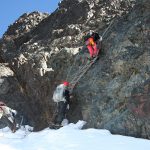Uganda has a series of block mountains and volcanic mountains that make it one of the most beautiful and scenic countryside. The block mountains include the famous Rwenzori Mountains also known as the mountains of the moon.
What is a block mountain and how is it formed?
Mountains in East Africa do vary based on their formation. Some have waves of white snow down the adjacent, the craggy steeps, while some have sky- stabbing points in the clouds with deep crater lakes on top. A block mountain is formed by natural faults in the earth’s crust. Mountain Rwenzori is the only block mountain in Uganda.
Rwenzori mountains
The Rwenzori mountains also known as ‘mountains of the moon’ are found on the border of Uganda and Democratic republic of Congo situated in the eastern rift valley. It’s the third highest mountain in Africa. The Rwenzori mountains rise above the clouds and are permanently snow capped. Margherita peak is the highest peak on the mountain. Other peaks include Mount Stanely, Mount Baker, Emin Pasha among others. There are several Rwenzori Climbing expeditions that will lead you to its glaciated peaks including the Magherita Peak on Mount Stanley.
What attractions are found on Block Mountains?
Snow peaks
The high Rwenzori comprises of six different mountains which can be reached by a hiker through the central circuit and Kilembe trails. Margherita is the highest of the snow peaks followed by Mount Stanley (5109m), Mount Speke (4890m) and Mount Baker (4843m) all bear permanent snow and glaciers.
Vegetation
Rwenzori mountains is well recognized for its diverse and beautiful flora than its fauna. The glacier- curved valleys of the Rwenzoriform a strange botanicl world inhabited by triffid- sized forms of rare groundsel and Lobelia, crisp everlasting flowers with coloured mosses and gnarled tree drapped with curtains of lichen. Hikers always pass through various altitudinal vegetation zones. From the tropical rain forest, to the tree heather montane forest, Afro-Alphine and bamboo. It is because of these world’s unique botanical communities that the mountains have been compared to the forests of the seven dwarves as well as the jabber wock and the unavoidable moiddle earth Tolkiens.
Lakes
There are over 20 lakes in Rwenzori mountains and probably the most accessible of all is lake Mahoma in the bird- rich forest of the central circuit. The beautiful lake Bujuku which lies at the Apex of the deep, glacier carved Bujuku valley in the shadow of mountains Stanely, Baker and Speke. In the Nyamwamba valley, they ascend through the trail in the Kilembe, glacier moraine deposited in the valley created dam which has formed a string of eight enjoyable lakes.
Birds
The mountain ranges are habitat to 217 species of birds and these involve various endemic Albertine rift species, of 17 species are endemic to the mountain Rwenzori national park making it an important birding area. The forest zone contains diversity of birds including the Rwenzori Turaco, handsome Francolin, Barred long tailed cuckcoo, Rwenzori batis, long-eared owl, Blue- headed sun bird etc.
Wildlife
The mountain hosts a population of around 70 mammal species, six species which are endemic to the Albertine rift valley, four species are endemic to the park and three are rare species. Other mammals include the Elephant as well as Rwenzori otter and leopard. Despite the Fact that wildlife is difficult to see, visitors can see blue monkeys, small antelope, bush bucks, three- thorned chameleon.


